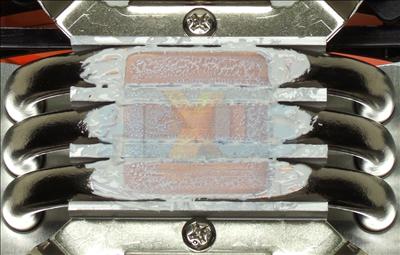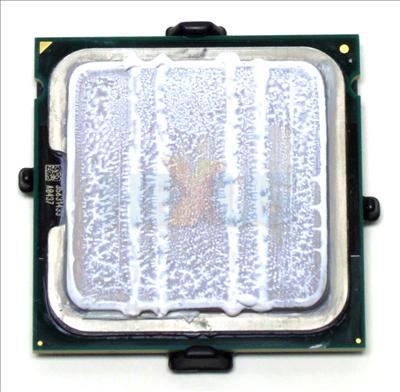Red Scorpion S1283 - installation and performance
Installation
The Red Scorpion S1283 follows the same installation procedure as the Achilles 1284, requiring you to attach the retention mechanism and fan, as well as apply the thermal interface material yourself.
The same criticisms that were levied against the installation of the Achilles can be directed towards the Red Scorpion - namely awkward to access retention push-pins, and less-than-ideal contact with the heatspreader due to the H.D.T. design.
At least all three heatpipes now make decent contact with the CPU's IHS, although the aluminium channels take up almost a quarter of the available surface area.
A look at the pattern the thermal paste leaves on the CPU again reveals the extent to which there are gaps between the heatpipes and the aluminium channels.
Performance
| Xigmatek Red Scorpion S1283 Tower Configuration | ||
| Idle | Load | |
| Ambient room temp | 23.8°C | 23.8°C |
| Case Temp | 27.6°C | 27.6°C |
| CPU Temp | 40°C | 64°C |
| System (NB) temp | 43°C | 43°C |
| GPU temp | 71°C | 70°C |
| CPU/Room Delta T | 16.2°C | 40.2°C |
| CPUCase Delta T | 12.4°C | 36.4°C |
| Xigmatek Red Scorpion S1283 Desktop Configuration | ||
| Idle | Load | |
| Ambient room temp | 23.7°C | 23.7°C |
| Case Temp | 26.1°C | 26.1°C |
| CPU Temp | 40°C | 65°C |
| System (NB) temp | 43°C | 43°C |
| GPU temp | 71°C | 70°C |
| CPU/Room Delta T | 16.3°C | 41.3°C |
| CPU/Case Delta T | 13.9°C | 38.9°C |
Summary
Again, there seems little reason to recommend the heatsink when cheaper and easier-to-install alternatives perform better.











